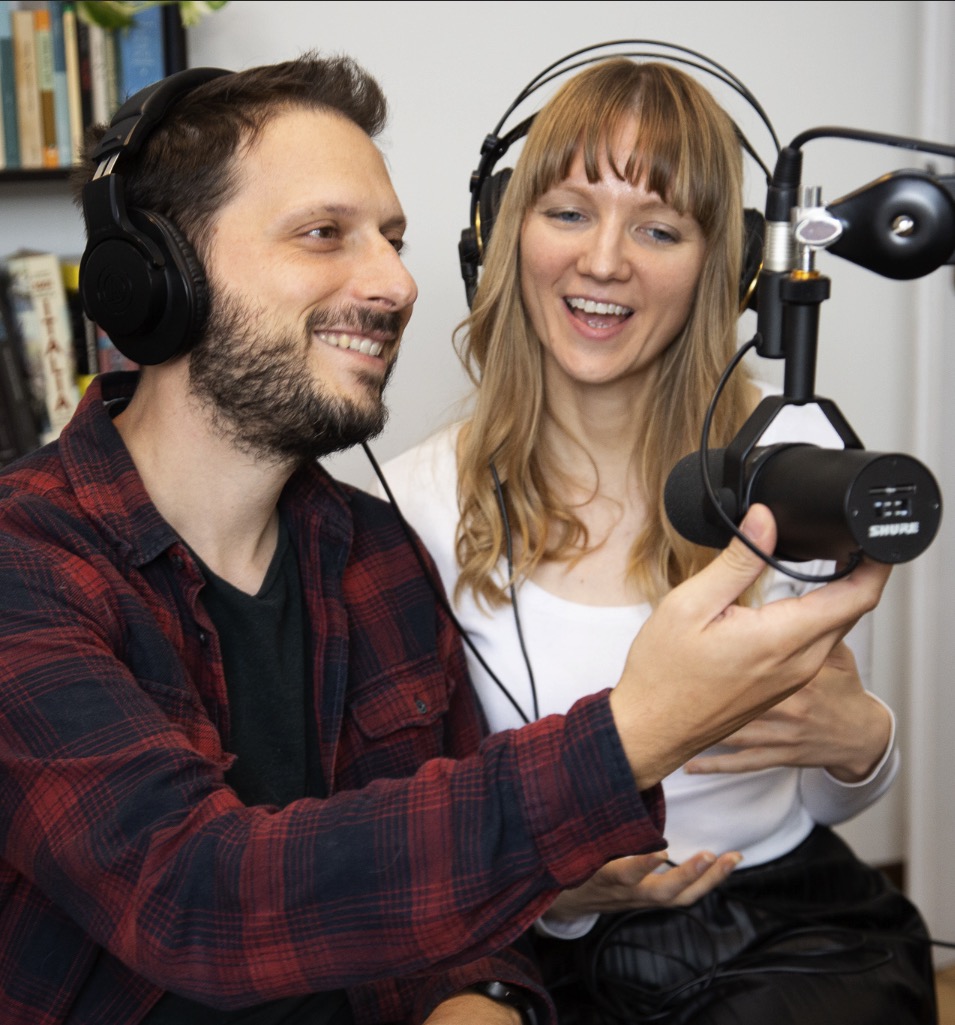The surprisingly simple way to learn a language
Learning a language and weight loss are similar: they’re typical examples of those big, exciting ideas that fill us with enthusiasm on New Year’s Eve. Yet when it comes to actually making those changes in January - eating broccoli instead of cake, or studying instead of watching Netflix - most of us would rather not bother. You could blame it on a lack of motivation and assume that these kinds of changes require a will of steel that’s not available to everyone (well, at least not to folks like me who stand in the fridge door nibbling on cheese whilst deciding what to cook for dinner). But Fogg’s experience showed the opposite: his technique worked because he’d found a way to make lasting changes which don’t depend on motivation or willpower. Read on to find out how Fogg’s tiny habits technique can help you create small but powerful language learning habits so you can achieve more this year. You'll learn:- How to learn a language easily, without making massive changes to your life
- Why you don’t need to feel motivated all the time
- The best way to create a language learning routine you can stick to
- How to keep going for long enough to get amazing results
Why motivation doesn’t work
It sounds logical enough. To achieve big goals, you should do big things. To lose weight, you should go to the gym 3 times a week and eat celery all day. To learn a language, you should sign up for a language course and study really hard all the time. We know these things are difficult to stick to in the long term, so we try to increase our motivation to help us keep going when things get gruelling. This explains why the internet’s full of “motivation hacks” to help you achieve this or that goal. But realistically, who can keep their motivation consistently high enough to keep doing these things when they don’t feel like it? I’m guessing not many. If you could, you probably wouldn’t be reading this post. If I could, I probably wouldn’t be writing this post. Approaches that rely on willpower or motivation are flawed because they ask you to “try harder” in the exact moment that you can’t be bothered to do anything. If I’m unmotivated, I don’t want to try harder. I want to eat cheese, and no amount of articles I read on lifehack is going to change that. So what’s the solution? Motivation is unreliable: it goes up and down, no matter how hard you try to sustain it. Yet we need it to do difficult things. No wonder so many of us struggle to make big changes like losing weight or learning a language.
Motivation is unreliable: it goes up and down, no matter how hard you try to sustain it. Yet we need it to do difficult things. No wonder so many of us struggle to make big changes like losing weight or learning a language.Tiny habits, big results
Professor Fogg knew that trying to boost motivation isn’t helpful for long-term changes. But he also knew that people tend to avoid doing difficult things when their motivation is low. So he looked at the problem from a different angle. What would happen if, instead of trying to increase motivation, he made changes that were so easy, it was almost impossible to say no? What if, instead of trying to do a few big things that were difficult, he did lots of teeny-tiny things, that were easy to repeat and make into habits? Say a couple of push-ups here, or a sip of water there? Over the year, these tiny habits accumulated, leading to the outcome that Fogg had hoped for: long-term weight loss. Think about the things you do every day, like opening the curtains, brushing your teeth or putting your shoes on. Do you need lots of willpower to do these things? Probably not. You just do them. The same idea applies to learning a language: if you establish lots of tiny language learning habits, you won’t need to feel highly motivated to do them. And over time, you’ll find it easy to make sustainable progress toward your language goals. Tiny habits may not sound as sexy as inspirational resolutions, but they work better. And remember: we’re talking about tiny habits, not tiny results. You’ll still be heading toward an exciting outcome, like being able to converse easily with native speakers. The idea behind tiny habits is that you’ll get there more easily by taking lots of baby steps. As Fogg points out: when you know how to create tiny habits, you can change your life forever. So if you want to learn a language this year, forget about big plans you’ll never stick to. Start with a tiny language learning habit. Here’s how.How to learn a language with tiny (but powerful) language learning habits
To establish effective language learning habits, there are 3 steps you’ll need to follow:1. Choose your tiny habits
Think about the outcome you'd like to achieve. Now break it down into a list of teeny-weeny actions you can take to get there. Here are a few examples:- Press play on my audio course
- Practice pronouncing one sound
- Learn one word
- Read a newspaper headline or the title of a book chapter
- Do one exercise from my textbook
- Review one verb form
- Press play on a YouTube tutorial
- Listen to one song
- Say/write one sentence
2. Hook them onto existing habits
Now you have your tiny habits ready, you’ll need something to remind you to do them, as BJ Fogg calls them, triggers. To make his tiny habit system as effective as possible, Fogg looked for simple triggers which would integrate smoothly into daily life, without having to worry about post-its or alarms. He found that the best way to do this was by attaching the behaviour onto habits we already have, such as brushing our teeth, getting home, or going for a wee. The trigger for his push-up habit gives a very clever (if perhaps not hygienic!) example of this:After I pee, I’ll do two push-ups
The keyword here is “after”. By adding your new tiny habit directly after something you already do several times a day, it's easy to repeat.3. Celebrate your victory
The last stage in Fogg’s tiny habit technique consists of doing a little celebration every time you complete your tiny habit. The idea behind this step is that firing up positive emotions makes your brain want to do it again, which makes the habit stick faster. This mini celebration can be whatever you want it to be, ranging from eccentric little dances or saying “I’m awesome!”, to more sober versions, like smiling, or thinking “well done”. Many people struggle with this part because it feels a bit silly. But if it’ll help you set up your habit faster, it’s worth a go. To be honest I’m just happy to have an excuse to do the running man in socks on my kitchen floor. Step 3: Do a mini celebration every time you complete your tiny language learning habit. It might feel a bit cheesy at first, but if it helps you get into the habit faster, it's worth a go!
Step 3: Do a mini celebration every time you complete your tiny language learning habit. It might feel a bit cheesy at first, but if it helps you get into the habit faster, it's worth a go!Building language learning habits: The virtuous cycle
How do 2 push-ups turn into 70? The tiny way of course! Getting started is the hard part. But once a tiny habit has taken root, it will naturally expand over time. If you’re in the habit of doing two push-ups, it’s easy to build up to 5. Once you’re in the habit of doing 5, it’s not hard to do 8. By doing this several times a day, you’ll suddenly find you can rack up 70 push-ups without much effort. Now imagine this in terms of language learning. Let’s say every time you get in the shower, you practice rolling your Rs once. By force of inertia, you’ll probably end up practicing for a few minutes anyway, especially once it starts getting easier. If you say one sentence to yourself whilst washing the dishes, you might still be talking to yourself as you walk around the house (this happened to me after lunch today). Once you’ve watched one foreign language YouTube video, you’ll probably end up watching a few more. And so on. Writer Sonia Simone recommends planning your tiny habits when you’ve got some spare time afterwards so you can take advantage of this forward motion. Just make sure you don’t start secretly planning to do more every time, as that'll make it harder to get started. As long as you’ve hit your tiny goal, you’ve won. Sticking to these goals, no matter how small, sets off a positive chain of events, helping you feel good about your efforts and encouraging you to let your language learning habits grow over time. Once your tiny language learning habit has taken root, it will grow over time and help you achieve sustainable language learning success.
Once your tiny language learning habit has taken root, it will grow over time and help you achieve sustainable language learning success.Building language learning habits: Troubleshooting
If you struggle to make your language learning habits stick, there are a few reasons this might be happening:Your language learning habit is too big
Remember, your language learning habit has to be so small that it’s easy to do, even on days when you don’t feel like it. If you’re still feeling resistance, the habit is probably too big.Solution
Strip your language learning habits down so that they’re so tiny, you could even do them on duvet days. Things like “press play on a French video” are much better than “write a paragraph in French”. Make the habit so easy, you can do it every single day (or several times a day), no matter what your mood is. This is the most important step because repetition is the key to lasting change. Avoid falling into the temptation of setting bigger targets so you can progress faster. It could hold you back in the long run. Just focus on doing your tiny language learning habits and the rest will come.You’re too busy
What if you have one of those days, weeks or months where you’re so busy you barely have time to take a shower or wash your socks?Solution
Keep those days in mind when you choose your language learning habits. Choose habits that are so small and easy, you can still do them on your most chaotic days. Then, when those days come around, remind yourself how important it is to keep up your habit during these times - that should help you make the tiny effort to get it done.Your schedule is unpredictable
Let’s imagine your tiny language habit is to practice counting in your head in Spanish whilst you brush your teeth. What if you go for a few drinks after work, then wake up the next morning on your friend's sofa with a fuzzy mouth and a cat on your head, realising that not only did you not brush your teeth, you also forgot to practice counting in Spanish?Solution
It’s no biggie to miss your habit once in a while. Just make sure you get right back to it. Writer James Clear has a “never miss habits twice” rule, which should help you stay on track. If your schedule is always different - for example, if you travel a lot - hook your language learning habits onto things you do every day, no matter where you are or what you’re doing. A few examples are: getting out of bed, getting dressed, leaving the house, washing your hands, taking your shoes off...Problem: You want to know everything, yesterday
One problem with the tiny habit technique is that it goes against that initial surge of motivation you get when you first decide to make a big change, like learning a language. At this stage, it’s tempting to charge ahead because it feels like you’ll make faster progress that way. But without good language learning habits, that rhythm will be difficult to maintain.Solution
Remember that this technique works because it’s all about baby steps. Be patient. Pour that initial enthusiasm into repeating a few tiny language learning behaviours until they become automatic, then celebrate as you watch them grow.My tiny language learning habits
This year, I’m going to use the tiny habit technique to start reading more. Reading in a foreign language awesome: it’s fun, helps you pick up vocabulary naturally and get exposure to typical sentence structures without feeling like “studying”. Despite the benefits, I’ve always struggled to get into the habit of reading foreign language learning books. I either find more exciting things to do, like eating cake and watching Netflix, or try doing it right before bed and fall asleep on the first page. In last week’s article, when I talked about my language goals for 2018, I mentioned that I’d like to build up to reading for 45 minutes in the evening. However, since researching this article, I’ve realised that having such a big number in my head probably isn’t the right strategy, as it will make things difficult to get started. So I’ve decided to keep things simple. I'm just going to focus on two tiny habits each day and hope that by force of inertia, I’ll end up reading a decent amount. Here are my two tiny language learning habits:After I make a cup of tea in the morning, I’ll read a paragraph of my book After I finish washing the dishes in the evening, I’ll read a paragraph of my book
I’ll keep you posted on how it goes!Your tiny language learning habits
Just reading this article probably won’t help you improve your language skills much. If you want to benefit from these ideas, it’s time to take action. Grab a pen and paper and write a list of tiny language learning behaviours that:- Hook on easily to your existing habits
- Are so tiny, they barely require any effort
After I (+ existing habit), I will (+ tiny language learning habit)
Examples of language learning habits
In need of a little inspiration? Let’s imagine you’re learning Spanish. Here are some tiny language learning habits you could get into:- After I make my morning coffee, I will read one headline in a Spanish newspaper.
- After I get in the shower, I will practice saying one word with the rolled r sound.
- After I leave the house, I will put my headphones on and press play on a Spanish podcast.
- After I reach the bus stop, I will review one word on my flashcard app.
- After I sit at my desk, I will review one verb form (make it easy by having a list ready on your desk).
- After I put the kettle on to boil, I will say one sentence to myself in Spanish.
- After I open my laptop, I will press play on one Spanish tutorial on YouTube.
- After I open Instagram, I will write or say one sentence in Spanish via the #languagediarychallenge (if you’re a complete beginner, try one word or very short phrase).
- After I finish the evening dishes, I will read one paragraph from a book of short stories for Spanish learners.
- After I put my pyjamas on, I will write one Spanish sentence about my day in my diary.
- After my head hits the pillow, I will think of one Spanish sentence in my head.
Time for some action
Pick 1 - 3 habits from your list and start doing them today.
If you’d like a little extra support, BJ Fogg runs a free online programme for developing tiny habits which you can join here.



